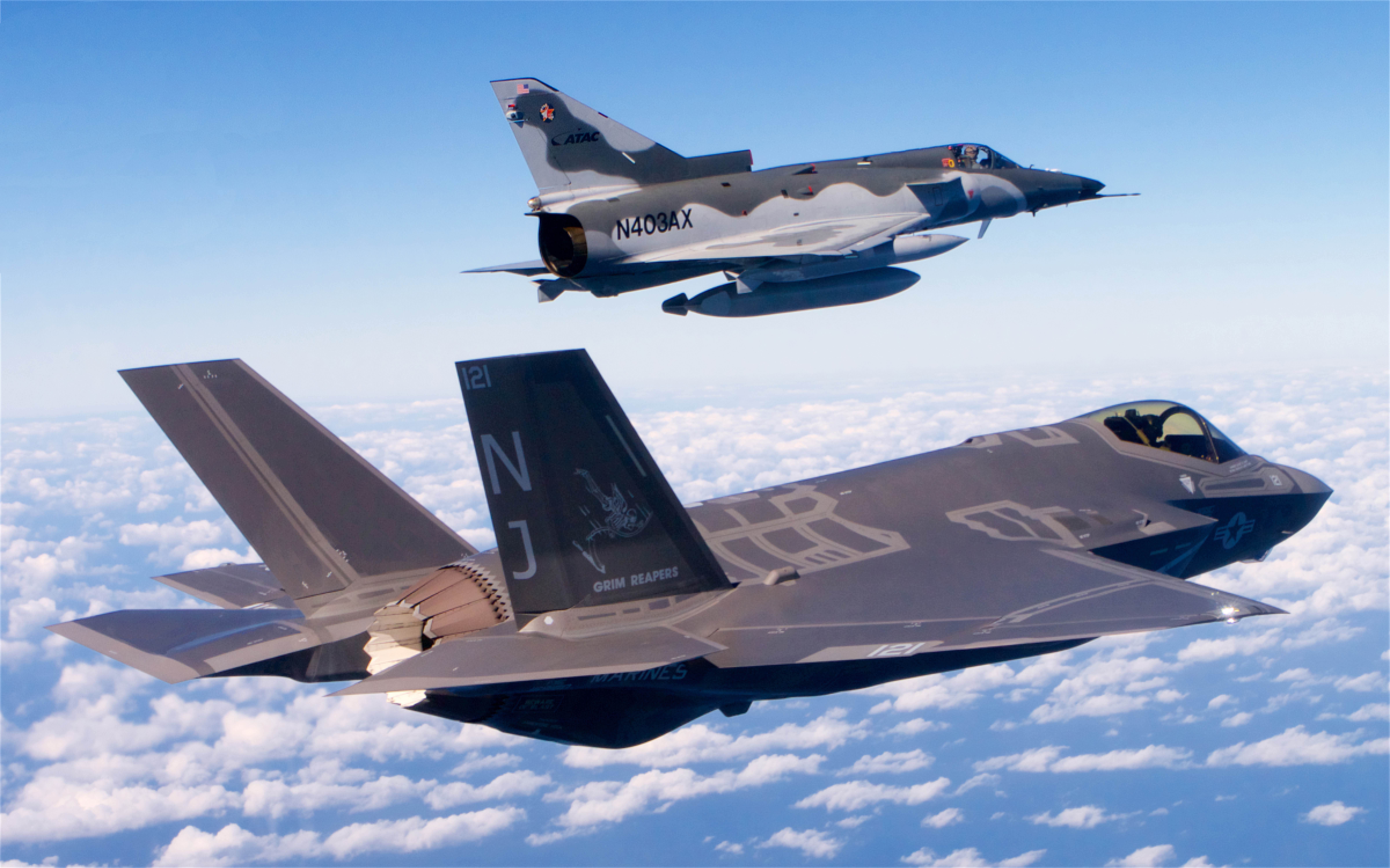An F-35 flies in the foreground during a training mission with an ATAC F-21 Kfir over the Gulf of Mexico in the spring of 2016. Photo courtesy of ATAC—A Textron Company.
The Air Force relies increasingly on contractors to provide “Red Air”—adversary aircraft for exercises—because its own aircraft are in short supply and it’s hard to spare pilots for the opponent mission. As a result, the service plans to release a draft solicitation to industry this July for nearly 40,000 hours of adversary air and support at 12 different bases, including 11,250 hours per year at the US Weapons School at Nellis AFB, Nev. The multi-award contract, which is expected in January 2019, has the potential to “consume the entire industry several times over,” said Russ Bartlett, President and CEO of Textron Airborne Solutions.
Seeing that USAF has gone down to just two aggressor squadrons, and that tight budgets continue to put a strain on overall flying hours, Textron acquired Airborne Tactical Advantage Company (ATAC) last year. The company had already accrued more than 40,000 flight hours training the US military since its 1994 inception.
The newly rebranded Textron Airborne Solutions has a contract with the US Navy through 2022, which keeps its fleet of 26 airplanes—including six supersonic Israeli F-21 Kfirs—extremely busy. That means the company is in the market for a whole new fleet to meet the Air Force’s needs.
“We hope to have that wrapped up by the end of March or early April, but we’re in good shape to respond to the [request for proposals] when it’s issued in April,” Bartlett told Air Force Magazine. He declined to say how many aircraft the company wants to procure, of what types, or from what sources, saying it’s not yet a done deal. However, he said the company is prepared “to bid on airplanes that we know and are familiar with,” promising additional details will be released soon.
“The need level is different for the Air Force,” said Tom Tyson, vice president of Textron Airborne Solutions. “Nellis needs this really bad right now. Other bases that are just starting to get the F-35, their need will grow over time.”
The Air Force wants to hire out for 36,231 hours of Red Air, which would cover 27,234 sorties per year with an average sortie duration of 1.3 hours. Here’s the breakdown the service provided to industry in mid-February:
- Nellis AFB, Nev.—11,250 hours per year; 7,500 sorties per year
- Seymour Johnson AFB, N.C.—3,885 hours per year; 2,590 sorties
- JB Pearl Harbor-Hickam, Hawaii—3,809 hours; 2,930 sorties
- Holloman AFB, N.M.—3,802 hours; 3,168 sorties
- Eglin AFB, Fla.—2,568 hours; 2,140 sorties
- JB Langley-Eustis, Va.—2,400 hours; 2,000 sorties
- Tyndall AFB, Fla.—2,304 hours; 1,920 sorties
- Kingsley Field, Ore.—2,074 hours; 1,728 sorties
- Luke AFB, Ariz.—1,766 hours; 1,472 sorties
- Hill AFB, Utah—1,152 hours; 768 sorties
- Tucson Arpt.—1,152 hours; 960 sorties
Once awarded a contract, the companies would provide everything, including airplanes, training, maintenance crews, and support. Some of the enterprise would be operated on base, while other parts will be at remote locations, said Bartlett.
The Air Force expects the winning companies to begin flying in May 2019, giving each time to build up their adversary fleets.
Although a live-virtual-constructive training architecture will become increasingly important as the F-35 force grows and the Defense Department looks for ways to train crews without exposing the fighter’s secrets, Bartlett said the February industry day focused primarily on the live-flying portion of the training.
“There is certainly an interest” in how the Air Force and industry can leverage LVC capabilities, but Bartlett said he expects it to be “an industry component we grow into.”
